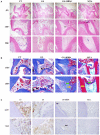Potential Application of Human β-Defensin 4 in Dental Pulp Repair
- PMID: 32973567
- PMCID: PMC7472722
- DOI: 10.3389/fphys.2020.01077
Potential Application of Human β-Defensin 4 in Dental Pulp Repair
Abstract
When pulp tissue is damaged by caries or trauma, vital pulp therapy (VPT) can help preserve the pulp tissue for long-term retention of teeth. However, the choice of pulp capping agent used in VPT is important for the successful preservation of the pulp tissue. Here we investigated the expression and biological function of human β-defensin 4 (HBD4) in dental pulp stem cells (DPSC) and explored its potential as a pulp capping agent. We examined the expression of HBD4 in DPSC in vitro using qPCR and immunofluorescence staining. We also looked at the effect of HBD4 on inflammatory factors in lipopolysaccharide (LPS)-stimulated DPSC, and its effects on mineralizing cell phenotype differentiation, via qPCR and western blot. Finally, we examined the ability of HBD4 to promote the restoration of the pulp-dentin complex in vivo, using male Wistar rats with reversible pulpitis. We found HBD4 was highly expressed in DPSC stimulated by TNF-α and IL-1α. HBD4 down-regulated the expression of inflammatory mediators (i.e., IL-1α, IL-1β, IL-6, TNF-α) in LPS-stimulated DPSC, and suppressed MAPK activity and the NF-κB pathway. HBD4 also enhanced the differentiation of DPSC into osteoblasts or odontoblasts, potentially by modulating the Notch pathway. Furthermore, HBD4 controlled the degree of pulp inflammation in a rat model of reversible pulpitis and induced the formation of restorative dentin. Together our findings indicate HBD4 may be a useful pulp capping agent for use in VPT.
Keywords: anti-inflammatory; dental pulp stem cells; human β-defensin 4; stem cell differentiation; vital pulp therapy.
Copyright © 2020 Zhai, Yuan, Zhao, Ge and Wang.
Figures





References
-
- Bogen G., Kim J. S., Bakland L. K. (2008). Direct pulp capping with mineral trioxide aggregate: an observational study. J. Am. Dent. Assoc. 139 305–315. - PubMed
-
- Fang T. J. Z., Yuan Z. Y., Zhao Y. M., Li X. X., Zhai Y., Li J. Z., et al. (2019). Synergistic effect of stem cells from human exfoliated deciduous teeth and rhBMP-2 delivered by injectable nanofibrous microspheres with different surface modifications on vascularized bone regeneration. Chem. Eng. J. 370 573–586. 10.1016/j.cej.2019.03.151 - DOI
LinkOut - more resources
Full Text Sources

